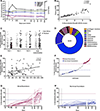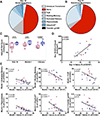B cell engagement with HIV-1 founder virus envelope predicts development of broadly neutralizing antibodies
- PMID: 33662277
- PMCID: PMC8245051
- DOI: 10.1016/j.chom.2021.01.016
B cell engagement with HIV-1 founder virus envelope predicts development of broadly neutralizing antibodies
Abstract
Determining which immunological mechanisms contribute to the development of broad neutralizing antibodies (bNAbs) during HIV-1 infection is a major goal to inform vaccine design. Using samples from a longitudinal HIV-1 acute infection cohort, we found key B cell determinants within the first 14-43 days of viremia that predict the development of bNAbs years later. Individuals who develop neutralization breadth had significantly higher B cell engagement with the autologous founder HIV envelope (Env) within 1 month of initial viremia. A higher frequency of founder-Env-specific naive B cells was associated with increased B cell activation and differentiation and predictive of bNAb development. These data demonstrate that the initial B cell interaction with the founder HIV Env is important for the development of broadly neutralizing antibodies and provide evidence that events within HIV acute infection lead to downstream functional outcomes.
Keywords: B cells; HIV; acute infection; broadly neutralizing antibodies; founder envelope.
Copyright © 2021 Elsevier Inc. All rights reserved.
Conflict of interest statement
Declaration of interests The authors declare no competing interests.
Figures







Comment in
-
Nature or nurture: Factors that influence bnAb development.Cell Host Microbe. 2021 Apr 14;29(4):540-542. doi: 10.1016/j.chom.2021.03.013. Cell Host Microbe. 2021. PMID: 33857415
References
-
- Bargatze RF, Jutila MA, and Butcher EC (1995). Distinct roles of L-selectin and integrins alpha 4 beta 7 and LFA-1 in lymphocyte homing to Peyer’s patch-HEV in situ: the multistep model confirmed and refined. Immunity 3, 99–108. - PubMed
-
- Berlin C, Bargatze RF, Campbell JJ, von Andrian UH, Szabo MC, Hasslen SR, Nelson RD, Berg EL, Erlandsen SL, and Butcher EC (1995). alpha 4 integrins mediate lymphocyte attachment and rolling under physiologic flow. Cell 80, 413–422. - PubMed
MeSH terms
Substances
Grants and funding
LinkOut - more resources
Full Text Sources
Other Literature Sources
Medical

